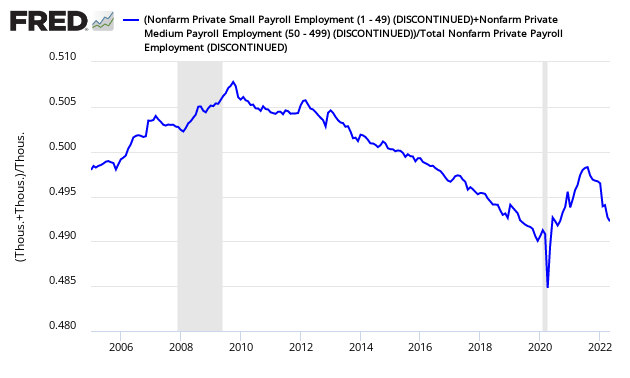Looking At Small Business Perceptions
I am not a fan of sentiment surveys. Sentiment can turn on a dime, and perceptions about what is occurring can be wrong. Of course if I were a campaign manager for a political candidate - I would feel entirely different. Managing perceptions is what political campaigns are all about.

For small business sentiment, movements in the short term are not reliable. As the grand-daddy of small business sentiment survey from the National Federation of Independent Business (NFIB) shows , there are apparently random month-to-month movements (noise).

Looking at the NFIB's Optimism Index - I conclude:
- Except for recessions - the index remained in a narrow range until the 2001 recession.
- Following the 2001, this index surged to a all time high in 2005.
- Then the index fell precipitously from 2005 until the end of the Great Recession.
- Currently the index has been in a general uptrend since the end of the Great Recession. It still has not returned to the range seen prior to 2001.
Is it true that small business conditions are worse today than they were prior to 2001? I believe so considering the rate of small business formation [hat tip The Brookings Institution]

IMO, small business formation reflects both the hardships (or perceptions of hardships) with owning a small business, or the changing belief whether small business is the road to Nirvana for Joe Sixpack. This Brookings study concludes;
Our findings stop short of demonstrating why these trends are occurring and perhaps more importantly, what can be done about it. Doing so requires a more complete knowledge about what drives dynamism, and especially entrepreneurship, than currently exists. But it is clear that these trends fit into a larger narrative of business consolidation occurring in the U.S. economy—whatever the reason, older and larger businesses are doing better relative to younger and smaller ones. Firms and individuals appear to be more risk averse too—businesses are hanging on to cash, fewer people are launching firms, and workers are less likely to switch jobs or move.
What is going on with small business is very important. It has been shown that small and medium sized business historically create most of the new jobs when using ADP non-farm private employment data. A continuing take from the ADP data is that small and medium size business continue to be the employment driver.
Ratio of ADP Under 500 person Business Growth to Total Business Growth

More than 3/4's of all jobs being created come from small business. Unfortunately, because the data series is new we do not know prior to 2005 what the historical contribution of small business to the USA employment growth. Nevertheless, paying attention to small business sentiment is important to the USA's economic health. And this past week the third issue of the Thumbtack Small Business Sentiment Survey (in conjunction with Bloomberg) was issued - and now there is a way to validate the NFIB's data from an independent source.
If I was King of the USA economy - it would be a major goal concentrate on small business, and work on improving small business formation through incentives or regulatory control holidays.
Other Economic News this Week:
The Econintersect Economic Index for July 2015 strengthened partially reversing last month's decline. Still, the tracked sectors of the economy remain relatively soft with most expanding at the lower end of the range seen since the end of the Great Recession. Thinking through the reasons for this month's increase, it was the improvement in a few areas from terrible to marginal growth.
The ECRI WLI growth index is now in positive territory but still indicates the economy will have little growth 6 months from today.
Current ECRI WLI Growth Index
The market was expecting the weekly initial unemployment claims at 270,000 to 275,000 (consensus 270,000) vs the 281,000 reported. The more important (because of the volatility in the weekly reported claims and seasonality errors in adjusting the data) 4 week moving average moved from 273,750 (reported last week as 273,750) to 274,750. The rolling averages generally have been equal to or under 300,000 since August 2014.
Weekly Initial Unemployment Claims - 4 Week Average - Seasonally Adjusted - 2011 (red line), 2012 (green line), 2013 (blue line), 2014 (orange line), 2015 (violet line)
Bankruptcies this Week: Privately-held Baha Mar
Disclosure: None.





